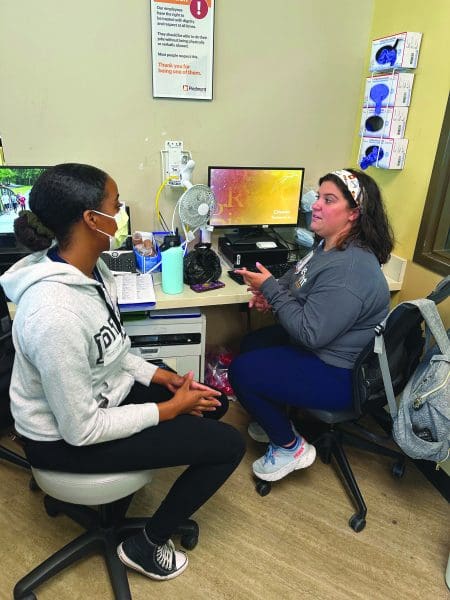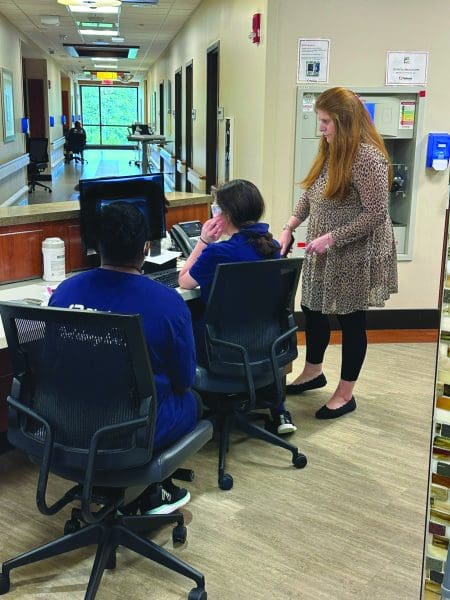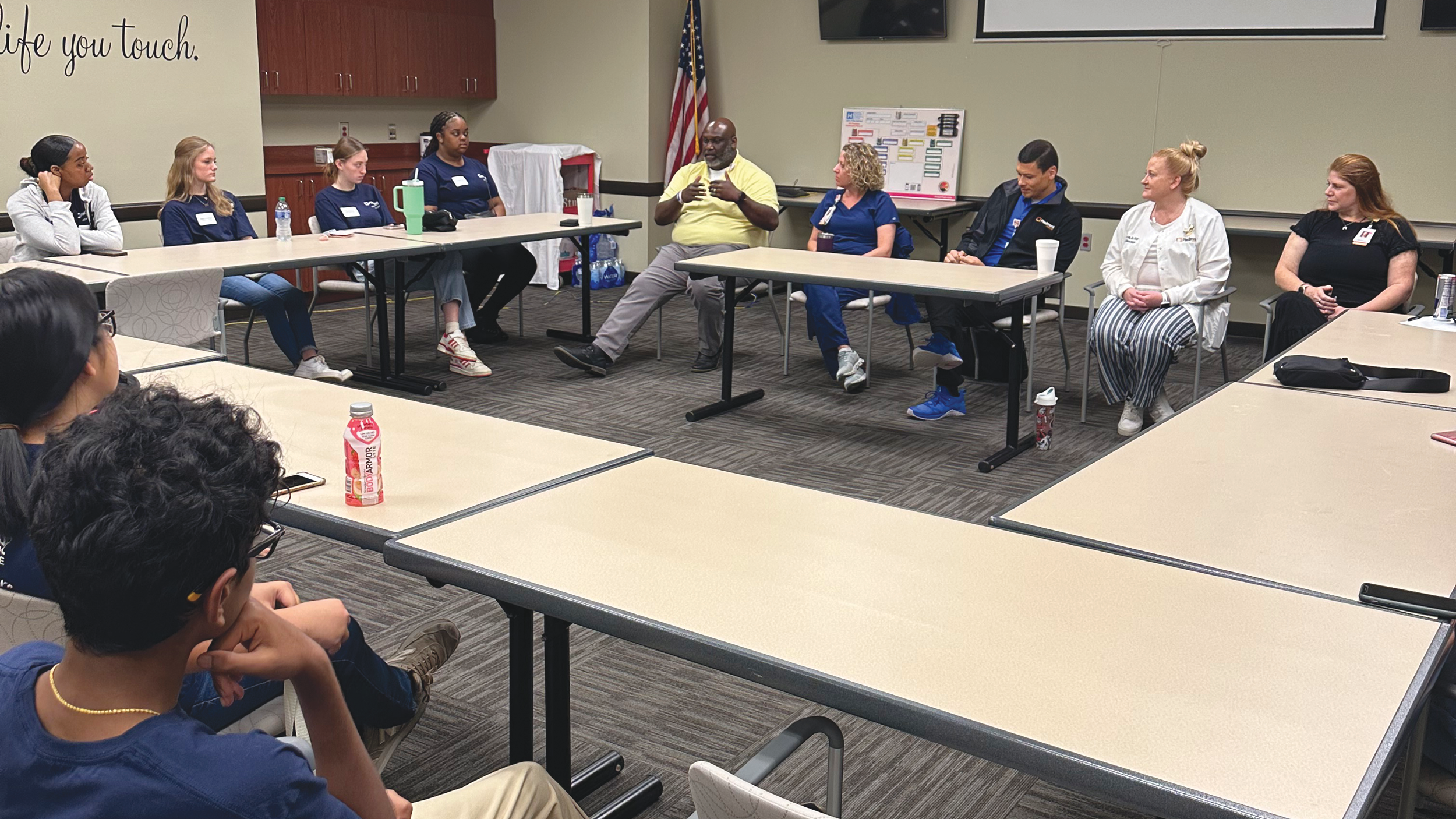A pipeline for rebuilding the nursing workforce
- Solving the nursing shortage requires creative recruitment strategies.
- An immersive experience at one hospital allowed students to witness the nursing role and its impact.
Piedmont Fayette Hospital, a 310-bed acute care hospital in Fayetteville, Georgia, continues to experience the impact of workforce shortages affecting many healthcare organizations. According to the World Health Organization, the United States will need to increase the number of nurses by 8% annually to close the current nurse gap by 2030. To help build a sustainable pipeline into the profession and the organization, a team of nurses at Piedmont Fayette Hospital developed a nurse camp for high school students.
Preparing RNs for emerging roles in primary care
The pressure is on: Why you should get your BSN
Nurse mentorships: A two-way street
Nurse camp
Nurse camp provides an opportunity to engage the community and drive interest in the nursing profession. This 3-day immersive experience targets high school students (juniors and seniors) interested in pursuing a career in nursing. More than half of the students are already on track in an allied health pathway.
Piedmont Fayette Hospital has a welcoming and learning culture. It accepts nursing school students for clinical rotations and senior practicums (approximately 250 have rotated through the hospital since January 2023) and for summer volunteer and shadowing programs. This culture made it easy to obtain support for the nurse camp program from nursing unit staff and managers.
The team
Five nurses collaborated to create the nurse camp program by sharing their individual perspectives and expertise. The distinct roles of team members included manager of nursing programs, nurse residency coordinator, clinical education coordinator, unit-based educators, and clinical bedside nurses. The nurse residency coordinator served as team leader. Each member demonstrated a commitment to teaching the next generation of nurses and rebuilding the workforce.
The agenda


The nurse camp team met monthly to discuss potential activities. Through collaboration and brainstorming, the group narrowed down and selected activities. The team discussed the costs, the number of available nursing staff needed to support the program, and other available resources. When considering the time required for each activity, the nurses agreed on a 2-hour limit for shadowing experiences to prevent overburdening the staff and to ensure student attention and engagement. The team allotted time for other activities based on their appropriateness and projected time for completion.
Using the activity outline, the team asked for staff nurse volunteers to support the camp as mentors and guides. Volunteers received role assignments based on their current position in the hospital and nursing background. All volunteers would receive credit toward Piedmont’s Clinical Advancement Program (professional development).
The budget
The team met with the chief nursing officer (CNO) to discuss the camp budget and to share a list of requested items (t-shirts, daily lunch, snacks, and supplies for first aid kits), which they estimated would cost $1,000. The CNO approved the budget with funding provided through organizational donations.
The promotion
The team used a combination of methods to distribute information about the inaugural nurse camp. They placed ads in the local community newspaper and distributed informational flyers to the local high school allied health teachers. The ads and flyers included the dates of the camp, a brief description of activities, and how to apply. Advertising in the local newspaper helped to reach students who don’t attend the public school (for example, those home-schooled or attending private school). This promotional approach allowed a variety of students the opportunity to apply.
The application process
To apply, students wrote a brief essay about why they wanted to attend the camp, their intent to pursue a role in nursing, and their career goals. The camp team reviewed and considered each application.
Of the 35 students who applied, the team selected 15 to attend the inaugural camp. This number factored in available resources and the nurse volunteers available to oversee shadowing experiences. Cost also played a contributing role. To address any student cancellations, the team selected five alternates.
The team notified selected students via email. The students completed documents in alignment with the organization’s standards regarding immunizations, vaccine requirements, and shadowing policy. Parents or guardians signed acknowledgement forms, which gave students permission to be in the presence of patients and that they would uphold all Health Insurance Portability and Accountability Act requirements. To ensure the camp team and organization could meet individual student needs, the documents also asked for information regarding food allergies or preferences, any medical conditions, and emergency contacts.
The timeline
Nurse camp took place in June 2023. Between October and December 2022, the team secured dates as well as space within the hospital to hold the camp. They held monthly meetings for 5 months before camp with one additional meeting the week prior to finalize details.
Each meeting included discussion of tasks, which were assigned to appropriate team members for completion before the next meeting. During these meetings, the team created the flyer and application form and worked to understand the documents the organization required for student attendance. The nursing student shadowing policy met the requirements.
In January 2023, the team distributed flyers and applications to local schools. In February, collaboration with the marketing team aided publication of the flyer in the local newspaper. Also, in February, the team contacted surrounding colleges and universities to invite them to attend a college fair to be held on the last day of camp.
The deadline for camp applications was May 1, which gave the team 2 weeks to review and accept students. The team notified students of their acceptance by May 15, and students had until May 31 to return documentation. Camp began on June 5.
Camp begins
The camp spanned 3 days. Each 7-hour day included time for lunch, breaks, and a debriefing session. (See Daily agenda.)
Daily agenda
Over the course of 3 days, students who attended the Piedmont Fayette Hospital high school nurse camp had the opportunity to meet nursing leadership, shadow clinical nurses, and participate in hands-on activities.
Day 1 (June 5)
0845 – 0930: Camper check-in, welcome, and ice breaker
0930 – 0945: Executive leadership welcome
0945 – 0955: Students divided into two groups for hospital tour
1000 – 1100: Hospital tour
1100 – 1200: Glo Germ handwashing activity
1200 – 1245: Lunch
1245 – 1315: History of nursing
1315 – 1415: Personal protective equipment education and relay race
1415 – 1430: Break
1430 – 1530: First aid kit creation and training
1530 – 1600: Debrief
Day 2 (June 6)
0900 – 1200: Basic life support training and certification
1200 – 1300: Lunch
1300 – 1330: Shadowing pre-brief
1330 – 1530: Shadowing experience
1530 – 1600: Debrief
Day 3 (June 7)
0900 – 1000: Nurse panel discussion and Q & A
1000 – 1230: Shadowing experience
1230 – 1315: Lunch
1315 – 1400: Disaster triage teaching
1400 – 1530: College fair
1530 – 1600: Closing
Day 1
The first day began by welcoming the students and inviting them participate in an ice breaker activity, in which they introduced themselves and discussed their interests and what they had in common. The activity allowed them to begin building bonds that would strengthen throughout the rest of camp. Next, the CNO and members of the executive leadership team greeted the students. They introduced themselves and shared their excitement for hosting the camp.
After the welcome session, the students split into two groups for a guided tour of the hospital. They visited various departments, including radiology, surgical services, the laboratory, and several nursing units. The tour leaders explained the purpose, role, and functions of each area and how the units operate. The tour facilitated student understanding of nursing’s role on interprofessional teams.
After the tour, students participated in a hand-washing exercise using Glo Germ gel to illustrate the importance of proper hand hygiene. They also listened to a presentation on the history of nursing to help them gain a better understanding of the background of the profession and the influence of several historical figures.
Next, the students created first aid kits. They decorated pouches, which they filled with basic first aid supplies such as burn cream, gauze, gloves, bandages, and tweezers. One team member used her clay molding skills to create wounds that replicated emergencies seen in the community, while others discussed with the students how to use each of the first aid items in real-life scenarios.
The last activity of the day focused on personal protective equipment (PPE), including proper donning and doffing technique. Students participated in a relay race to demonstrate the skills learned. After dividing into four teams, each student properly donned the provided PPE and then ran to the next table to properly remove it. If a student donned or doffed the PPE out of order or if contamination occurred, they started over.
Day 2
The second day of camp began with students attending a basic life support class conducted by certified instructors. At the end of the course, students took an exam and received American Heart Association Basic Life Support certifications.
In the afternoon, students learned about proper shadowing etiquette. The team leader then paired two students each with a nurse to shadow. For 2 hours, the students observed the nurses on their units providing patient care, charting, and performing procedures. Hospital shadowing policy allows for observation experience only, but students were encouraged to ask questions. The team and students respected and accommodated any nurses or patients who didn’t want to participate.
Day 3


A unit manager and staff RN explain nurse responsibilities and the charting process to a student.The final day of camp opened with a nurse panel discussion, which included nurse educators and managers from multiple service lines with years of clinical practice. A new nurse graduate also sat on the panel to share their journey. The panel answered students’ questions about entering the profession, why they chose their career paths, tips for navigating nursing school, and how to prevent burnout.
Feedback
The team sent a follow-up survey to students via email; nine of the 15 returned it. The survey asked students what they enjoyed about the camp, what they would change, and how camp impacted their desire to become a nurse. The students responded positively. One said, “I loved it all!!!” and another said, “Thank you so much for the opportunity! I deeply appreciate everyone who made camp possible, and I definitely learned from it!”
Positive feedback from the planning team and volunteers included the students’ level of engagement. The students immersed themselves in the experiences and seemed eager to learn. Other positive feedback included the flow and organization of the camp and that the balanced difficulty of activities created a challenging, positive learning environment.
Team debriefing revealed several opportunities for modification, including a shortened time frame for each day. Students stated that the 7-hour days left them tired. The team plans to shorten each camp day to 6 hours. They also intend to shorten the application process. Some students reported that the lag time between application submission and notification of acceptance impacted their ability to plan other summer activities.
Build the pipeline
Ensuring a robust nursing profession and quality patient care requires building a pipeline of future nurses. Hospitals and other healthcare organizations must take steps now to educate young people about nursing careers and engage them in activities that help them understand all of the options. Creative approaches, such as the Piedmont Fayette Hospital high school nurse camp, provide students with a glimpse into their future.
The authors work at Piedmont Fayette Hospital in Fayetteville, Georgia. Halea Caudill is the nurse residency coordinator, and Gloria Giordano is manager of nursing programs.
References
Fulton JS. Rebuilding the nursing workforce. Clin Nurse Spec. 2023;37(1):3-4. doi:10.1097/NUR.0000000000000725
World Health Organization. State of the world’s nursing 2020: Investing in education, jobs and leadership. 2020. iris.who.int/bitstream/handle/10665/331677/9789240003279-eng.pdf?sequence=1
Key words: nurse camp, nurse recruitment, nurse shortage


















